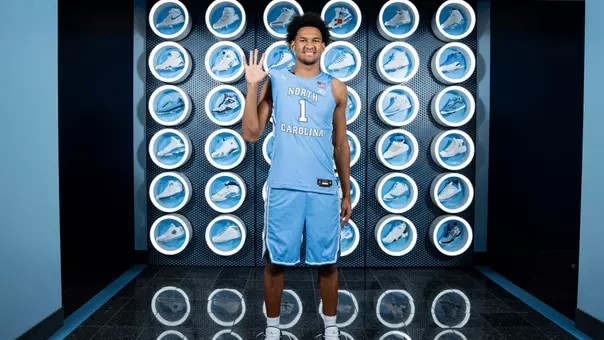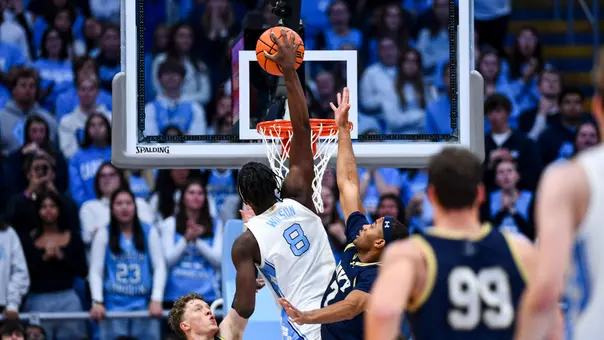University of North Carolina Athletics

Kenny Williams
Photo by: Rhona Wise
Lucas: Better Ball Movement
January 19, 2019 | Men's Basketball, Featured Writers, Adam Lucas
Carolina is assisting at a near-historic rate this season.
By Adam Lucas
CORAL GABLES—Think of the very best passing Carolina teams.
You're undoubtedly picturing Kendall Marshall firing a perfect hit-ahead pass to John Henson, or Ed Cota flipping a nifty behind the back pass to Vince Carter, or maybe Kenny Smith beating everyone down the court and dropping a bounce pass to Brad Daugherty for the dunk.
None of those teams averaged more assists per game than the 2019 Tar Heels are averaging right now.
Carolina handed out a generous 26 assists in Saturday's win over Miami, meaning just seven baskets were unassisted. That takes this year's team average to 19.4 assists per game, which would be the most for any Tar Heel team since the 1990-91 squad averaged 20.0 per game.
If you don't remember, the point guard on that 1991 group was King Rice, and therein lies the key to a high number of team assists. It doesn't always depend on one spectacular floor general. It's more likely to follow a team where everyone takes some responsibility for distributing the ball.
Coby White led Carolina with eight assists against the Hurricanes, but Kenny Williams added seven and Luke Maye and Brandon Robinson each had four. The Tar Heels haven't had a double-digit assist game from an individual yet this year, but six different players have led them in assists in a game—all five starters plus Seventh Woods.
"We're not really ball dominant with certain players," said Cameron Johnson. "We're not iso-ing guys. We're looking for each other. We really want to make plays for each other and keep the ball moving."
That's even more true as individuals find their better fit in the offense. For the second straight game, Nassir Little aggressively took the ball at the rim rather than settling for jump shots. Even Garrison Brooks has figured out how to find his teammates; the big man distributed ten assists in 13 nonconference games, and now has 13 assists in five league games.
That's part of an overall trend upward for Carolina's ball movement, as the Tar Heels are averaging more assists in league play (19.6) than they did in nonconference games.
Some of the ball movement on Saturday was gorgeous. On one second half possession, both Little and Robinson passed up reasonably open three-pointers to find Williams for that rarity in college basketball—an open midrange jumper on the baseline, which Williams knocked down to give the Heels a six-point lead. Jim Larranaga's team tried both man to man and zone, but Carolina carved up both options.
Williams has almost as many assists this year (72) as he did in 37 games last year (88). There's a reasonable chance at least three Tar Heels will surpass 100 assists for the season, something that's only been done three times in the Roy Williams era. Two of those teams—the 2009 and 2016 squads—played until the final Monday night of the season.
But, you're certainly wondering, what about the turnovers? Yes, imagine how proficient Carolina's offense could be if they just held on to the ball. During one first half stretch, the Tar Heels scored on 11 straight possessions on which they did not turn the ball over. Improbably, though, they were only +1 during that stretch, because they committed four turnovers during that same span.
The reason for optimism is that it's still a freshman, White, at the controls for most of those minutes, and he's still learning—it's just mid-January, and to put it into context this was the exact weekend of the season when Marshall took over starting duties as a freshman—when to push the tempo, when to find his teammates, and when to look for his own offense.
The rookie had three turnovers in Saturday's first half, including two Roy Williams deemed "ridiculous," then responded with a zero-turnover effort (to go with seven second-half assists) in the final 20 minutes.
"I was finding guys in their spots and I was playing within myself," White said. "I wasn't trying to make the home run play in the second half. A lot of times, just trying to take care of the ball forces you to make the easy play. The easy play is always the right play."
Overall, Carolina's 26 assists were the second-highest total of the season, trailing only the 29 against Tennessee Tech. Not coincidentally, it came on a day when five Tar Heels were in double figures, forcing Miami to cover everyone on the court. And, as Roy Williams loves to say, it also happened on an afternoon when the ball went in the basket, as Carolina shot 55 percent from the field.
But that almost feels like it's discounting the Tar Heel offense too much. Under Larranaga, Miami heavily emphasizes stopping the Carolina transition game. The Canes regularly took players off the lane during free throws to thwart any UNC attempt at a quick break, and Carolina had just six fast break points.
In other words, almost all of the offense was accomplished against a set defense, and often in the halfcourt, an area where Carolina sometimes struggles. This wasn't simply a matter of the Tar Heels playing faster than the opponent. This was good offense and shot-making.
"A lot of the time it's not something that any one guy is doing," Kenny Williams said. "It's just making the easy play, making the play we're supposed to make, and guys are finishing plays."
It helps that assists remain a valued statistic in the Tar Heel locker room. As the players dressed for the flight home in what turned into a less than 24-hour road trip, someone mentioned to White that he had eight assists. No one particularly seemed to care that he also had 15 points and continues to be one of the highest-scoring freshmen in a loaded conference.
"You had eight assists?" Kenny Williams boomed from the adjacent locker. "That's my boy!"
CORAL GABLES—Think of the very best passing Carolina teams.
You're undoubtedly picturing Kendall Marshall firing a perfect hit-ahead pass to John Henson, or Ed Cota flipping a nifty behind the back pass to Vince Carter, or maybe Kenny Smith beating everyone down the court and dropping a bounce pass to Brad Daugherty for the dunk.
None of those teams averaged more assists per game than the 2019 Tar Heels are averaging right now.
Carolina handed out a generous 26 assists in Saturday's win over Miami, meaning just seven baskets were unassisted. That takes this year's team average to 19.4 assists per game, which would be the most for any Tar Heel team since the 1990-91 squad averaged 20.0 per game.
If you don't remember, the point guard on that 1991 group was King Rice, and therein lies the key to a high number of team assists. It doesn't always depend on one spectacular floor general. It's more likely to follow a team where everyone takes some responsibility for distributing the ball.
Coby White led Carolina with eight assists against the Hurricanes, but Kenny Williams added seven and Luke Maye and Brandon Robinson each had four. The Tar Heels haven't had a double-digit assist game from an individual yet this year, but six different players have led them in assists in a game—all five starters plus Seventh Woods.
"We're not really ball dominant with certain players," said Cameron Johnson. "We're not iso-ing guys. We're looking for each other. We really want to make plays for each other and keep the ball moving."
That's even more true as individuals find their better fit in the offense. For the second straight game, Nassir Little aggressively took the ball at the rim rather than settling for jump shots. Even Garrison Brooks has figured out how to find his teammates; the big man distributed ten assists in 13 nonconference games, and now has 13 assists in five league games.
That's part of an overall trend upward for Carolina's ball movement, as the Tar Heels are averaging more assists in league play (19.6) than they did in nonconference games.
Some of the ball movement on Saturday was gorgeous. On one second half possession, both Little and Robinson passed up reasonably open three-pointers to find Williams for that rarity in college basketball—an open midrange jumper on the baseline, which Williams knocked down to give the Heels a six-point lead. Jim Larranaga's team tried both man to man and zone, but Carolina carved up both options.
Williams has almost as many assists this year (72) as he did in 37 games last year (88). There's a reasonable chance at least three Tar Heels will surpass 100 assists for the season, something that's only been done three times in the Roy Williams era. Two of those teams—the 2009 and 2016 squads—played until the final Monday night of the season.
But, you're certainly wondering, what about the turnovers? Yes, imagine how proficient Carolina's offense could be if they just held on to the ball. During one first half stretch, the Tar Heels scored on 11 straight possessions on which they did not turn the ball over. Improbably, though, they were only +1 during that stretch, because they committed four turnovers during that same span.
The reason for optimism is that it's still a freshman, White, at the controls for most of those minutes, and he's still learning—it's just mid-January, and to put it into context this was the exact weekend of the season when Marshall took over starting duties as a freshman—when to push the tempo, when to find his teammates, and when to look for his own offense.
The rookie had three turnovers in Saturday's first half, including two Roy Williams deemed "ridiculous," then responded with a zero-turnover effort (to go with seven second-half assists) in the final 20 minutes.
"I was finding guys in their spots and I was playing within myself," White said. "I wasn't trying to make the home run play in the second half. A lot of times, just trying to take care of the ball forces you to make the easy play. The easy play is always the right play."
Overall, Carolina's 26 assists were the second-highest total of the season, trailing only the 29 against Tennessee Tech. Not coincidentally, it came on a day when five Tar Heels were in double figures, forcing Miami to cover everyone on the court. And, as Roy Williams loves to say, it also happened on an afternoon when the ball went in the basket, as Carolina shot 55 percent from the field.
But that almost feels like it's discounting the Tar Heel offense too much. Under Larranaga, Miami heavily emphasizes stopping the Carolina transition game. The Canes regularly took players off the lane during free throws to thwart any UNC attempt at a quick break, and Carolina had just six fast break points.
In other words, almost all of the offense was accomplished against a set defense, and often in the halfcourt, an area where Carolina sometimes struggles. This wasn't simply a matter of the Tar Heels playing faster than the opponent. This was good offense and shot-making.
"A lot of the time it's not something that any one guy is doing," Kenny Williams said. "It's just making the easy play, making the play we're supposed to make, and guys are finishing plays."
It helps that assists remain a valued statistic in the Tar Heel locker room. As the players dressed for the flight home in what turned into a less than 24-hour road trip, someone mentioned to White that he had eight assists. No one particularly seemed to care that he also had 15 points and continues to be one of the highest-scoring freshmen in a loaded conference.
"You had eight assists?" Kenny Williams boomed from the adjacent locker. "That's my boy!"
Players Mentioned
Head Coach Bill Belichick Pre-Duke Press Conference
Wednesday, November 19
Carolina Insider: Rapid Reactions pres. by Modelo – Men’s Basketball vs. Navy – November 18, 2025
Wednesday, November 19
Hubert Davis Post-Navy Press Conference
Wednesday, November 19
UNC Men's Basketball: Wilson, Tar Heels Soar Over Navy, 73-61
Wednesday, November 19












